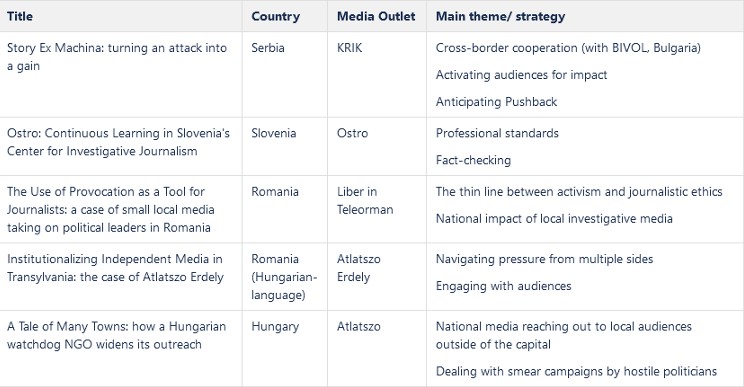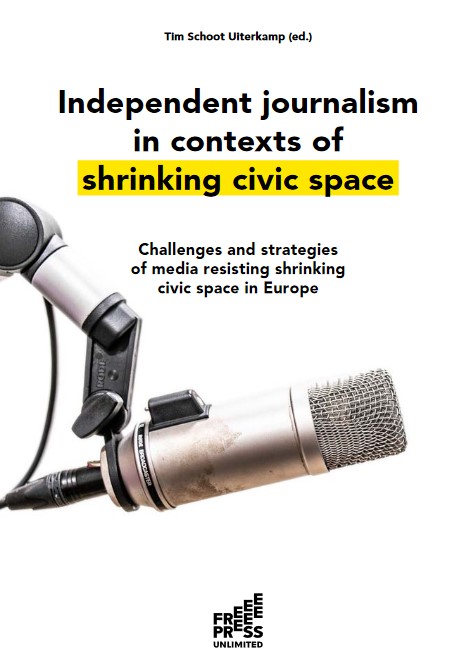By Tim Schoot Uiterkamp
On Wednesday the 12th of May, Free Press Unlimited launched a new publication: Independent Journalism in Contexts of Shrinking Civic Space.
The publication focuses on the challenges independent media face as a result of shrinking civic space and the strategies that they can use to deal with these challenges. These are explored through case studies, with contributions of media experts from four different countries. This is put into a theoretical framework centered on democratic backsliding and the role that independent media have to play in upholding (liberal) democracy.
The result are a set of recommended practices and strategies to inspire independent media facing similar challenges. While the publication is primarily concerned with the needs and perspective of media practicioners, media support organisations and policy makers can use these conclusions as well, to determine which efforts are likely to be effective and should be supported.
The launch of the study is was marked by an event on the situation for independent media in Europe, together with journalists from Central Europe and several Members of the European Parliament.
Watch event and interview
The launch event was recorded and can be watched here: link to recording on YouTube
Study author Tim Schoot Uiterkamp (Free Press Unlimited) was interviewed about the publication on Studio Free Press Matters, which can be seen here: Studio Free Press Matter interview.
Context
‘Shrinking civic space’ is a trend that is manifesting itself across the world, including in Europe. In this phrase, ‘civic space’ refers to the sum of all conditions that allow individuals and organisations to participate, organise and communicate outside of the control of the state or the market. Its boundary is defined by three fundamental rights: the right to association, the right to peaceful assembly, and the right to freedom of expression.
This process is tied to the rise of regimes that have been described as illiberal democracies or electoral autocracies. Their intention is to remove or neutralise norms and institutions that limit or hold accountable those in power. As a result, powerful political actors are increasingly able to constrain public discourse; manipulate elections and evade accountability. To illustrate: in 68% of the countries that have become autocratic in recent years, this was started by an elected incumbent rather than by a military coup.
Governments in these electoral autocracies appeal to two sources of legitimacy for their policies: the fact that they have won a majority in elections in the past, and a notion that ‘people are living better’ under their rule (‘output legitimacy’). Over time their policies to shrink civic space and change the electoral playing field make it easier to win subsequent elections. In theory, these elections can still be lost though, especially if the claim to ‘output legitimacy’ is threatened. This makes it vital for powerholders to prevent independent media from uncovering corruption and examples of poor governance.
Shrinking civic space involves efforts by powerholders to prevent independent media outlets from continuing to operate, by limiting their ability to access public information, reach an audience and achieve impact. This is because independent media function as a check to their power, by fostering accountability for their actions and decisions as well as by bringing the various problems facing various groups in society to the public’s attention. When they do so successfully, media outlets contribute to keeping civic space open, creating a space for individual citizens and groups in society to scrutinize decisions affecting them and to air their grievances.
To sum up – independent media face serious challenges as a result of shrinking civic space, but they are also a part of the solution.
Cases and findings
The publication includes five case studies, which have been selected to illustrate different strategies.
They are:

Shrinking civic space manifests itself differently across countries, depending on the possibilities and priorities of those in power, the overall context of civil society, and the media landscape. By embedding the descriptions of strategies applied by existing media outlets in a thick description of the context, we enable readers to assess to what extend their context and challenges are similar to those found in each case study.
Some recurring observations across cases are the importance of local journalism; the influence that the context of the media landscape as a whole has on the challenges facing individual outlets; and clear examples of how the problem can spread across borders if not checked.
The success of illiberal actors in one country in capturing media outlets and other institutions that are meant to check government power can empower political actors in other countries to govern in the same way. At the level of ideas, it contributes to normalising illiberal ideas on democracy, such as a delegitimisation of counterpower. This can be seen in the spread of the aggressive language by powerholders and governments towards critics and independent media. Furthermore, one government taking restrictive measures can create precedents that make it easier for other governments to do the same.
Concretely, illiberal governments can support each other in European affairs or undermine civic space across borders. The spread of media capture by illiberal governments, as one relevant example of this, is well-documented, particularly from the network around the Hungarian Prime Minister Viktor Orban. In this publication, the influence of this network is observed in both the Slovenian case study and the case study on Hungarian-language media in Romania.
The findings from the case study chapters are synthesized in the Conclusions chapter. It contains recommendations of practices and strategies, clustered by objective or problem area:
- Section 1: All audiences have access to independent media
- Reaching wider audiences
- Effective and independent local media
- Section 2: Independent media are seen as credible
- Professional standards
- Resisting delegitimization
- Section 3: Independent media hold powerholders to account
- Accessing information
- Impacting accountability
These strategies range from verification processes, to in-house training or cross-border collaboration.

